Artists at Work: Jim Shaw
by Julian Hoeber
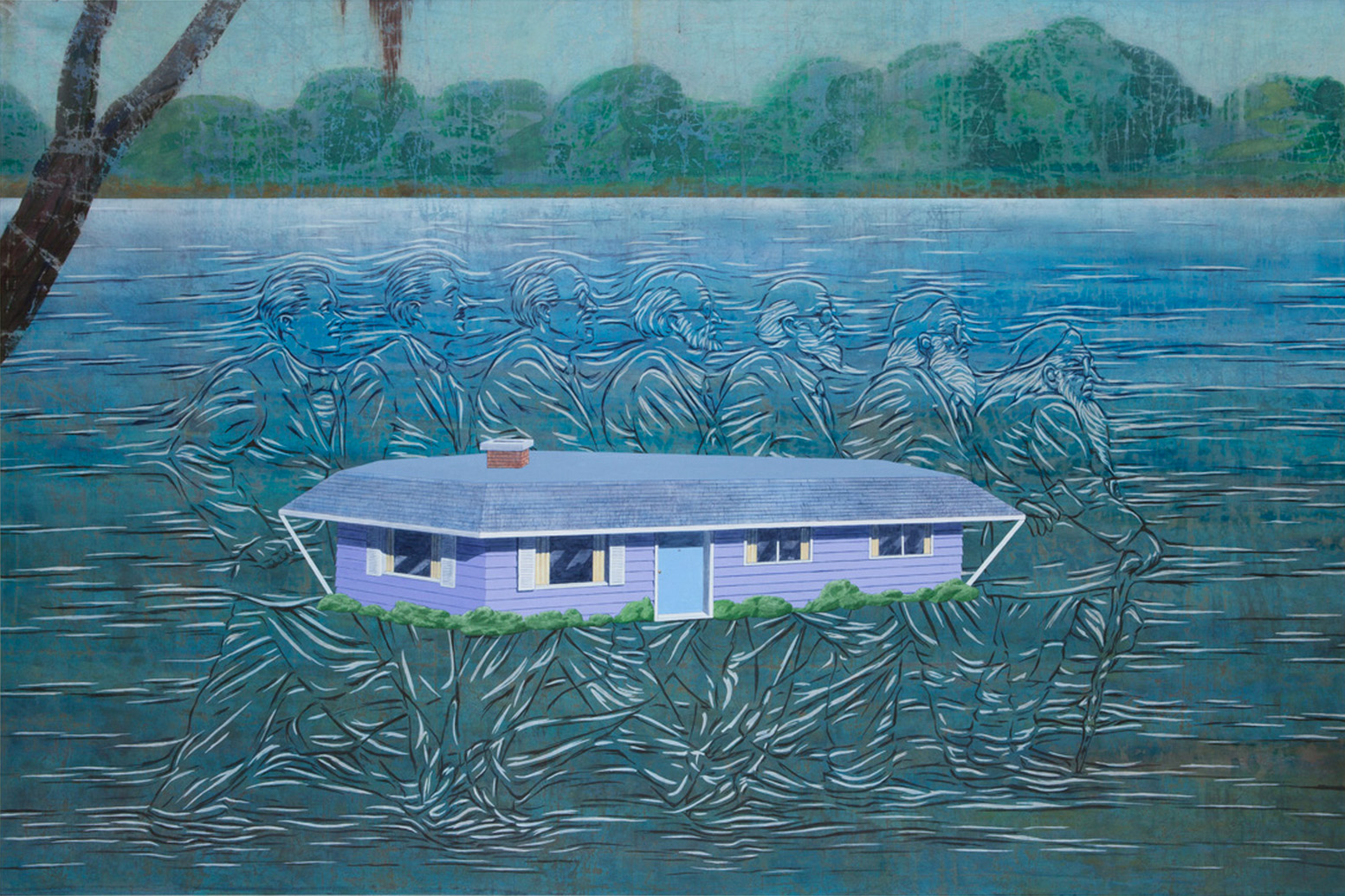
Jim Shaw, The House in Mississippi, 2013. Acrylic on muslin, 72 x 108 inches. Courtesy of the artist and Blum & Poe, Los Angeles.
Jim Shaw is a major figure in contemporary art whose career began in music, with his early collaborative work with Mike Kelley in the 1970s anti-rock band Destroy All Monsters. Since then, he has gone on to work in a range of media, from drawing and sculpture to performance, producing a perverse and radical reimagining of American culture. I worked for Shaw for several years, getting an up-close view of how he developed his work, which often started with a joke or coincidence that would later become a beautifully crafted object. We met in October 2013, as he was getting ready for his most recent solo exhibition, at Blum and Poe in Los Angeles, to discuss art history, psychoanalysis, and the ways that unconscious processes inform his highly conceptual practice.
JULIAN HOEBER: Can you talk a little bit about your method with the Dream Drawings series, which you began in 1992? I had the impression that you’d become so good at the process that you began to re-create something like dreaming in waking life.
JIM SHAW: I had to because once my daughter was in school, I couldn’t sleep in anymore and couldn’t get the extra bonus sleep you get when you don’t have a job. I would start by recording the dream verbally into a Walkman tape recorder. I still had a backlog of dreams to deal with for a while, but new ones were few and far between once she started school. I’d taken note of them; I just hadn’t made any artworks out of them.
JH: The surreal things that happen in the nondream works—like The Hole [2007] and The Donner Party [2003], for example—seem very much related in style and imagery to the Dream Drawings. Did the practice of recording your dreams make some of this other free-associative thinking develop?
JS: I think that, in all truthfulness, it boils down to manic activity in the brain, a form of magical thinking. Before I was drawing my dreams, I was doing My Mirage, for instance. I was doing a lot of free association with that series. I suspect some of it came out of beatnik poetry. It’s like when Robert Downey Jr. is acting, he is basically riffing like his father’s beatnik friends, or so he says. For me it’s kind of the same thing. You go, “This means that, and this is related to that,” so you have these branched forms that occur, and if you can keep the magic and the mania happening, it works out well. It’s all absurd but also a lot of fun. It’s the manic activity that goes on in your brain as it’s going, “Bing, bing, bing, bing.” There was a lot that Mike used to do that was about free-associative, absurd connections. So I don’t know if I picked it up from Mike or from William Burroughs.
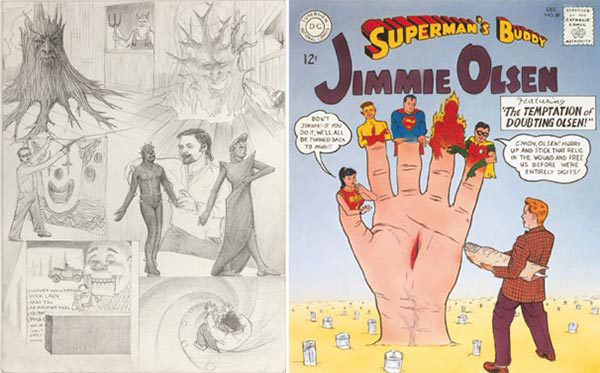
Left: Jim Shaw, Dream Drawing (I was in a Vegas show about a Viking farmer…), 1995. Pencil on paper, 12 x 9 in. Courtesy Blum & Poe, Los Angeles.Right: The Temptation of Doubting Olsen, 1990, from the My Mirage series.
JH: Can you speak about those influences a bit more and the importance of free association in your work—this was something you picked up from Mike?
JS: Well, I think this is the way that Mike sometimes worked—and this is just my interpretation, since he’s not here to defend himself. A Voyage of Growth and Discovery [2010], the piece that he did with Michael Smith, was supposedly based on the fact that Mike Smith had this character, Baby Ikki, who had a pacifier, and that people at raves used pacifiers. It was also about the fact that Baby Ikki would never have a transcendent experience. In a way, it’s also about everything you could come up with involving making sculptural forms based on Burning Man and the weird imagery of this baby walking around in the desert and The Wicker Man and things associated with that. So there are things beyond the stated purpose at work there. Sometimes the stated purpose, if you isolated it, would seem weak. That would certainly be true of my stuff. Some of it is also a challenge to the self, to see what kind of art can be spun out of base matter.
JH: Thinking about the process of translating dreams into language and how it’s a form of rewriting—you have to make a conscious reformulation of the dream in order to record it, and putting words to it always changes the memory. It’s very slippery. And then how much of that happens in the rendering of the drawing? To what extent is your process in waking life similar?
JS: Some of the work that I do comes from visions that I might have while I’m waking up. I just want to pursue those visions, and the tough part is that if I pursue them purely and directly, it either is, or verges on, being stoner art. So the trick is trying to find some way in which it can both be serious and not just be stoner art.
JH: Why is the seriousness important?
JS: Because it’s not a joke. I’m not joking about this image. It’s an image that came to me as I was in a half-conscious state, and I want to implement it. If it is presented as fake stoner art, then people can accept it. But if it’s presented as real stoner art, then it’s not acceptable. It’s like the [artist] Reverend Ethan Acres—his teachers were going, “Well, he’s not serious, is he?” It was okay if his preaching was part of the artwork, a type of performance, and he wasn’t serious, but if he was serious about it, it wasn’t okay.
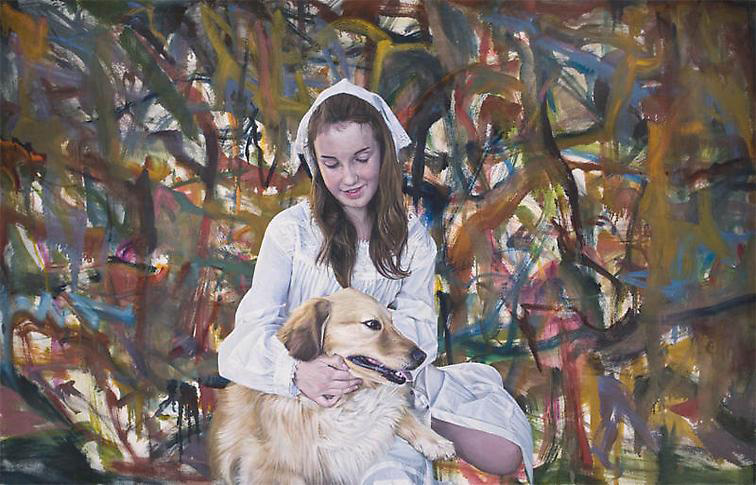
Left: Jim Shaw, Oist Children Portrait (Girl & Dog), 2011. Oil on canvas, 47 x 73 in. Courtesy of the artist and Metro Pictures.
JH: Since you bring up religion, I want to get to some of the relationships between this way of working and your Oism series. Could you give a brief description of that body of work?
JS: Oism is my version of a false religion and history upon which to hang a bunch of artwork. It has turned out to be the hardest project I’ve ever done, in part because of the amount of research it has required. My first big project, My Mirage, was easier because a lot of it was based on things that happened to me or my friends as teenagers. There was a lot of research involved, including research on American religions that popped up in the past. One of the ones that caught my attention was the Universal Public Friend, a woman who claimed to be—though without saying so directly—the reincarnation of Christ in upstate New York. I later found out that her home base was right where my grandpa’s cottage was, on Keuka Lake. They just changed the name of the town from New Jerusalem to Branchport. One day she died, and her lieutenant hid the fact from everyone for a while until the body started smelling bad, at which point it all fell apart.
Anyway, I’d been looking at these things for a long time and somehow decided that I would make that the focus of this fake religion, Oism, which would also be in upstate New York. It’s where feminism began in America, Seneca Falls. It was also the locus point of spiritualism and the antislavery movement. So I decided to put those things together in an imaginary religion that has its own false history like the Mormons, who were also based in upstate New York before they followed Brigham Young to Utah.
JH: With the free-associative practice, in which you find things that connect to each other and then you start riffing, you have a very particular way of doing it. I always understood Oism as having gotten its name from its central symbol being this circle, in the same way that the cross is the central symbol of Christianity—there’s always the joke in there of Xs and Os.
JS: The other joke is that it’s the essential feminine. The God figure [in Oism] is a virgin who gave birth to herself in the year 4000 B.C. or so. Her teachings lead to a civilization that, in her absence, goes all awry and top-heavy and falls beneath the ocean—disappearing until the 1840s, when Annie O’Wooten channels the book of Oism in upstate New York on Keuka Lake.

Left: Jim Shaw, The Donner Party, 2003. Mixed media. Installation View at P.S.1, 2007. Photo by Matthew Septimus. Courtesy P.S.1 Contemporary Art Center.
JH: I’m thinking of this thing that my psychoanalyst used to say about how the ability to make jokes is evidence of a healthy interplay between the conscious and unconscious mind.
JS: I do sincerely believe, after looking at my own dreams, that puns are the language of the subconscious. Rather than state things directly, it picks and chooses visual and verbal puns, sort of like Jesus’ parables. That’s where looking at dreams and figuring out those things can be useful if you want to analyze stuff. I also think it functions well in artwork to have visual puns. There are a lot of mash-ups, for instance, in the new paintings. In my painting Seven Deadly Sins [2013], the element of pride is visualized as a mash-up of Washington Crossing the Delaware and The Raft of the Medusa.
JH: There’s also an image in there of The Death of Marat.
JS: I put myself as Marat as the dreaming artist here. It’s been mashed up with three other pieces: The Nightmare and Blake’s etching I Want! I Want! , and The Dream of Reason Breeds Monsters by Goya. Marat is supposed to represent sloth, but at the same time it’s Jacob and Jacob’s ladder, which is a spiraling DNA ladder going up to heaven—
JH: —and heaven is the castle from Disneyland, yes?
JS: Well, it’s Disney-esque. That’s supposed to be greed, and it’s from The Ring Cycle—it’s Odin’s greed in cheating the frost giants out of their pay for creating Valhalla, which is like the ideal home.
These are supposed to refer to our own deadly sins. I have the deadly sin of pride in thinking I can make a triptych based on the seven deadly sins in an effective manner. I’ve got the need to have a nice house somewhere, which refers back to Brecht and Weill’s [1933 ballet] The Seven Deadly Sins—the family and society castigate the main character’s faults, relating to those sins, but which are really the welling up of normal human emotions, which get in the way of her paychecks, which are needed to pay for the family house on the Mississippi.

Jim Shaw, Seven Deadly Sins, 2013. Acrylic on muslin, 94 x 196 inches. Courtesy Blum & Poe, Los Angeles.
JH: The combination of images makes me think of how pop culture and art history function side by side in your work. Whereas we think of dreams as being so personal, you’re often working with this pop and historical material that is very much collectively owned.
JS: I have a lot of well-known popular tropes in my own dreams. For example, if I was watching David Letterman, there would be a good chance something from David Letterman might show up in a dream. Everything I ever saw could easily show up in a dream one day.
JH: With an artist like David Salle, there’s a pile of references that often seem completely disconnected; whereas with your work, there’s actually a stream. There is a connection, with all the elements structured but in this unconscious, manic way.
JS: I figure that there are two meanings to any work. There’s the meaning that the artist intends, and then there’s the meaning that the viewer gets out of it—those can be two completely different things. Then there’s a third one for really well-known historical works like the Mona Lisa, where there is a meaning well outside of any actual value the painting has. To me, it’s like when we look at a Bosch or Brueghel. We can’t know all of the reference points that would have been there for a viewer at the time, especially for a Bosch or any Dutch painting—they had a ton of meanings that are lost to us. We’re in the post-meaning era.
There was a time when meaning was a joke in itself: “It’s about man’s inhumanity to man.” That was the joke about explaining an Abstract Expressionist painting back when I was a kid. And yet I want there to be meaning in my painting. I want it to be like a Bosch or a Brueghel without actually being a Christian. Oist artworks wouldn’t exist if I hadn’t come up with the structure within which they could exist, but I imagine that the structure is less important than I’ve actually said it is.
JH: This points back to that thing you were saying about the Mike Kelly/Michael Smith Baby Ikki piece, about having this idea that you start riffing on to generate other forms—that the original idea is productive of something, rather than being the point in and of itself.
JS: A lot of times I would think that whether Mike [Kelley] or I admitted it, there is another hidden layer of meaning, a personal layer of meaning that is nobody’s business necessarily. Something like his Mobile Homestead piece—there are layers beyond the specific meaning in there. I can’t speculate in his case on those, and sometimes maybe it’s better that they remain mysterious.
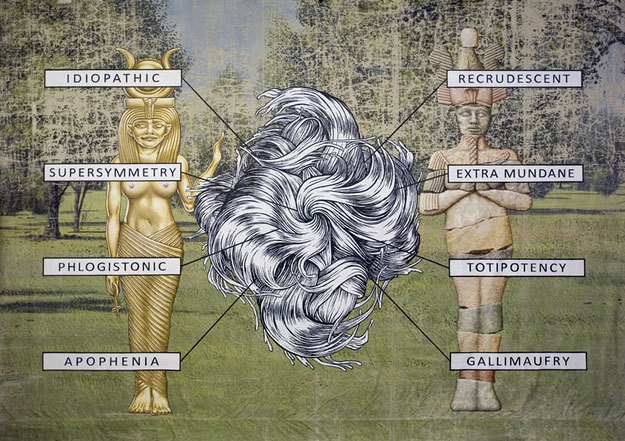
Jim Shaw, Anal/Isis, 2012. Acrylic on muslin, 96 x 120 in. Courtesy Simon Lee Gallery.
JH: This is an interesting thing to me because making art as I was growing up and even into undergraduate art school, I always had this very romantic idea that the whole point was this layer—the one that you’re saying is unspoken. At a certain point, you don’t want to speculate about the intentions of Mike or any other artist, but people obviously do. I wonder what the place of that is—how do we have a discussion about that stuff? Is it counterproductive to start unraveling that other, personal layer?
JS: I don’t think so. But it’s also like trying to analyze why Hitler or Nixon did something. You can look at a letter he wrote to his mom where he calls himself a dog and extrapolate a lot out of that, but it’s just your opinion. That’s the problem with it—Mike didn’t leave a lot of specifics. People can speculate because he’s not here anymore and you can’t stop them, but only the artist’s shrink or someone like that would know the specifics.
JH: What about in your own work?
JS: My speculations about myself are based on some pretty simple psychological things. I had this one student who was telling me about his own paintings, which were really loose and thematic, and we were speaking about the style that he used. He said, “Well, I’m not like one of those artists who’s going, ‘Mommy, Mommy, look what I can do!’” And I realized, I am one of those artists! I think when you’re a perfectionist, that’s a major part of it: trying to impress the distant parent figure who’s not easily impressed.
Then there’s the manic thing: It’s like a drug to be hopped up on ideas. For me, it’s manic-depressive, but I’m not that depressed. During the depression part, I’m rendering stuff. There are long periods of rendering. The manic part is when I’m going, “This plus this is this! Wow, that’s exciting! It will be a lot of fun to make all of those things!” Maybe they don’t add up and they’re worthless, pointless extrapolations, but it’s the fun period.
JH: It’s the fun period, and then there is this other phase when you’re doing all of the rendering. Is the rendering therapeutic?
JS: It’s a balm, sort of.
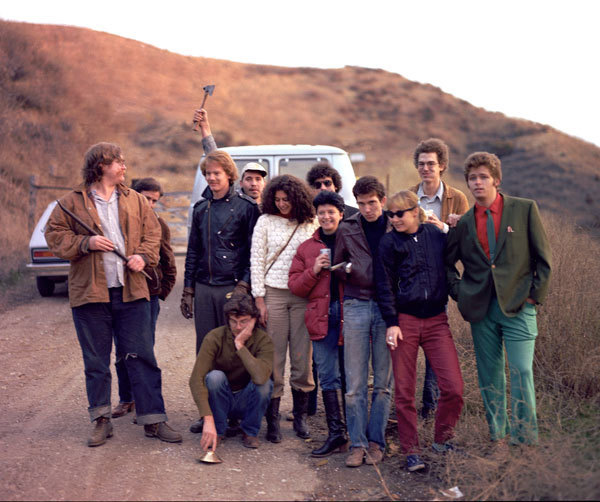
Shaw (right) and classmates at CalArts, ca. 1976-78.
JH: You were talking about the gifted child, and it’s evidenced in the tremendous technical facility in all of your work. I remember years ago you said something, and maybe it was an offhand thing one says and you weren’t serious, but it struck me: You said that at the particular time that you were at CalArts [1976–78] it was a very rigorous, conceptualist place. You pursued some conceptual elements as a way to have a reason for doing this thing you loved to do, which was drawing, because there was no place for representational or figurative drawing at that moment at CalArts—you had to find a way to make it acceptable to do that. Do you still feel like that kind of conceptualist pressure is relevant?
JS: I think that self-hatred as a motivating force is still relevant. Going to a place like CalArts, you wanted to be rigorously self-critical. The unfortunate fact was that a lot of people just stopped making art under those circumstances. In a way, it was like they were trying to weed out the weak by making it so fucking rigorous, because the art world is going to do that to you eventually. I just wish they wouldn’t charge so much tuition for that process of convincing people they shouldn’t be artists. Of course, it’s true of other institutions as well.
JH: I had the experience at graduate school that the only thing left of you when you’re done is what you can’t bear to let go. Everything is negated and pushed. The people who continue to be artists are the people who survive that scrutiny and pressure and still want to make their work.
JS: There is so something about grad school—actually, one of my students said they were told something to the effect of, “We don’t want you to come out of here doing the stuff you did when you came in.” Literally, if someone does that, they’d feel like they had failed as teachers. Even if they were coming in as a genius—someone like Mike came in as a genius but managed to very quickly give up on his painting skills.
In a way, that’s all for the better, because if he was going to differentiate himself from the work of the past, he had to get rid of the influences like Jim Nutt or someone like that. But in my case, the things that were influencing me the most were things that were never in the art world that much—popular illustration, for example.

L to R: Jim Shaw, Ron Asheton, and Mike Kelley at Second Chances in Ann Arbor, 1975. Photo: Cary Loren.
JH: I think it’s amazing that you and Mike were able to carry this working relationship and friendship from the early music stuff you did in college in Michigan in the 1970s through CalArts and well into your mature careers. You both seemed to have set up methods of working in which a fairly rigorous conceptual underpinning leaves room for the unknown to seep into the making of the work, allowing you to end up somewhere that couldn’t have been predicted at the start. The experience of the work isn’t reducible to one original idea.
JS: Maybe. It’s up to the viewer to determine whether we have or not. The problem here is that after going to CalArts I came believe that the show is the thing; the show contains all the important threads. So then I always found myself in this last-minute, insane, impossible-to-produce-all-the-threads situation. Of course, the art world has since gone on past that, to the sales at the art fair and so on. It’s where the money really is. So you work your ass off to create this whole environment—the show—and the people with the big money don’t fly to Los Angeles to see it. They might see it online or something, or their art buyer or art adviser might see it, but they’re not getting the full experience.
JH: Right, and the full exhibition becomes this other thing that exists on screen—you’re working in this way that’s almost a funny kind of relic.
JS: Yeah, it’s a relic of the 1970s and ’80s. Like now I’ve set up all these ideas that I wanted to impart before my next show opens, and I just don’t have enough time to execute them the way I did with the first half of the show. There’s one piece—and it was never going to be a particularly sexy piece—that was something I really wanted to do. It was in the form of an Ad Reinhardt cartoon satire called How to Look at Faces that disparages artists who find faces in things, which of course I do. I wanted it to be done with collaged engravings and type, and it would talk about the actual biological reason for finding faces, which is related to fight or flight—being able to see a predator in the landscape. That becomes its own kind of weird psychological state. But there’s just no time to finish that piece.
JH: I think your work functions outside of that particular context, though. I know you want to finish everything in time for the show, but a person can track a lot of these threads over time by looking at the individual works in relation to the total arc of your career. You’re talking about puns and the repetition of shapes, but that also takes on the quality of motif within the whole oeuvre.
JS: Yeah, I’m hoping so. There’s a certain level of—and this is part of the burden of not only being a perfectionist, but also being the artist who was first known for collecting thrift store paintings—if these things look like thrift store paintings, then I’m sort of in the wrong place. But sometimes getting it right screws up aspects of the painting.
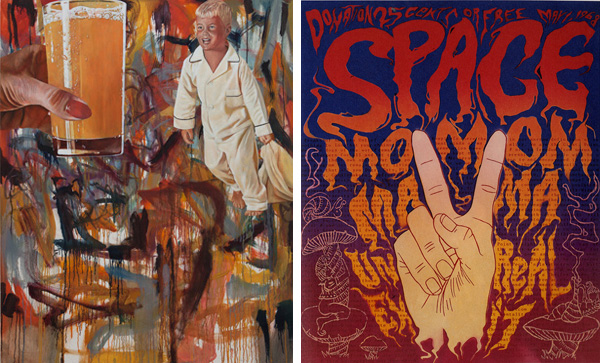
L: Jim Shaw, Orange Juice Ad, 2013. Oil on canvas 60 x 48 x 2 7/8 inches (152.4 x 121.9 x 7.3 centimeters). Courtesy of the artist and Blum & Poe, Los Angeles, CA. R: Jim Shaw, Space, 1990, from the My Mirage series.
JH: Right. You’ve forced yourself into a position of having to paint it perfectly, as in this piece you’re working on now [Orange Juice Ad, 2013] of a boy in his pajamas and a glass of orange juice that come from an old advertisement.
JS: With a mom, perhaps with sexy fingernails, holding the orange juice as a symbol of a future of pure consumerism.
JH: You had a fairly Freudian description of it earlier.
JS: Yeah, that the orange juice in the mom’s hand is the breast being proffered. For me, as a kid, Sucrets and orange juice were among the symbols of masochism. Sucrets was something that we were always given if we had a cold. They were medicated throat drops, and they basically obliterated the ability to taste. As a kid, we also got frozen orange juice. We didn’t get fresh-squeezed orange juice, so I thought that orange juice was this bitter, horrible stuff and that oranges were bitter and horrible tasting. I never had fresh-squeezed orange juice or a fresh orange because the orange juice was so horrible.
JH: This is a little glimpse of the personal, psychological layer you were talking about.
JS: I see these pictures of kids from these ads that I’m utilizing as being, of course, little versions of me.
JH: I did want to ask something about the way Pop functions much more iconographically in your work than it does in that of many other artists. I think of the psychedelic poster typography in My Mirage as transforming some of the meaning of those subcultural images you’re taking from EC Comics or Peter Max—
JS: Which was my culture at the time. Yeah, I can go with that.
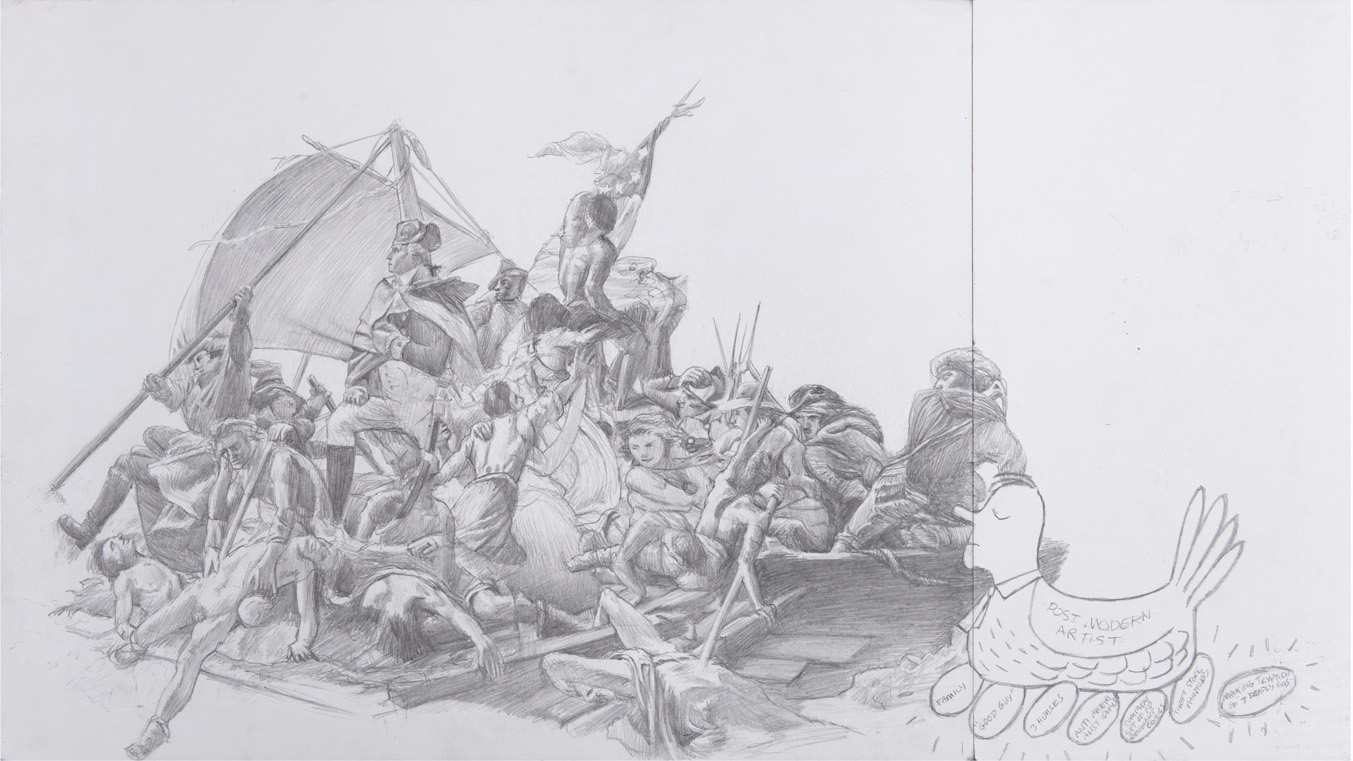
Jim Shaw, Study for “Seven Deadly Sins”, Pride, 2013. Pencil on paper, 11 x 19.5 inches. Courtesy of the artist and Blum & Poe, Los Angeles.
JH: The historical images in the new paintings seem to function the same way, iconographically. This thing you were saying about mashing up The Raft of the Medusa—
JS: The Raft of the Medusa was a politically engaged painting that worked in the politics of France at the time. It must have been known by American painters, because things got reproduced in various forms. So I’m curious if the artist who did Washington Crossing the Delaware was consciously aping the forms or if that’s just what happens when you’ve got a bunch of poles occurring out there in the water.
Years ago, I did a painting based on a dream—it was maybe the first conscious mash-up I did, but it was from a subconscious source—and it was Nude Descending a Staircase on this spiral staircase that was basically the staircase from The Golden Stairs by Edward Burne-Jones. He’s a late Pre-Raphaelite. When I was doing the mash-up through a morph program, it started looking to me that Nude Descending a Staircase, No. 2 actually may have been based on that earlier painting by Burne-Jones, because the forms seemed to line up exactly. That could just simply be a delusion on my part, but it really looked very, very related to the forms of The Golden Stairs, which was not an unknown painting.1
JH: I would like to think that you’re right. I think sometimes we undercredit this intertextual relationship between paintings that occurred before Postmodernism. It seems completely plausible.
JS: When I was studying William Blake, I was just looking at him for a long time thinking, How interesting, how strange, how weird—but then finding out that he idolized Michelangelo and that most of Blake’s education is drawn from pre-existing artworks, specifically ones that were either in England or reproductions. He didn’t draw from figures. So whatever Michelangelo’s take on the figure was, that influenced Blake’s take on the figure. He considered Rembrandt to be this awful modern artist who was in league with the Deists. He thought that trying to apply rational thinking to the world was a big mistake, and in some ways he’s right. This is a big mistake, rationally dividing the world.